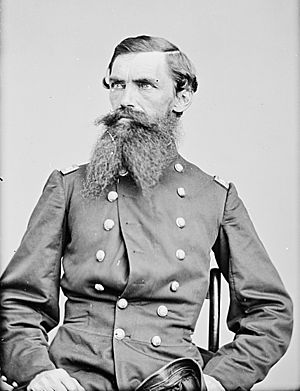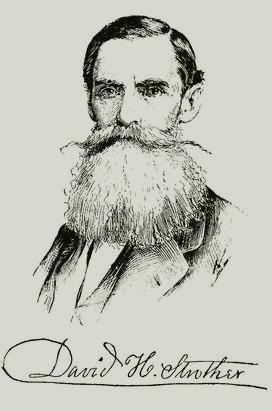David Hunter Strother facts for kids
Quick facts for kids
David Hunter Strother
|
|
|---|---|

Strother during Civil War
|
|
| Born |
David Hunter Strother
September 26, 1816 |
| Died | March 8, 1888 (aged 71) Charles Town, Jefferson County, West Virginia
|
| Resting place | Green Hill Cemetery, Martinsburg, West Virginia |
| Occupation | Journalist, artist, politician, military officer, diplomat |
| Spouse(s) | Anne Doyne Wolfe Mary Elliott Hunter |
| Parent(s) | Col. John Strother, Elizabeth Pendleton Strother |
David Hunter Strother (September 26, 1816 – March 8, 1888) was an amazing American journalist, artist, and even a military officer and diplomat from West Virginia. He was super famous in the 1800s for his magazine stories and drawings. People knew him best by his pen name, "Porte Crayon" (which means "pencil holder" in French).
Before and after the American Civil War, Strother was a very successful writer and illustrator. He even helped his dad run a big hotel in Berkeley Springs, West Virginia. This hotel was a popular spa that people could reach by train. During the Civil War, he worked as a mapmaker for the Union Army. He eventually became a brevet Brigadier General. After the war, he helped rebuild the Virginia Military Institute. He also served as the U.S. consul in Mexico for several years.
Contents
Early Life and Family Fun
David Strother was born in Martinsburg, Virginia (which is now West Virginia) in 1816. His parents were Colonel John Strother and Elizabeth Pendleton Hunter. David was the first of their eight children and the only boy to grow up. His family had a long history in Virginia, with many important leaders and soldiers.
His grandfather fought in the American Revolutionary War. His father was a lieutenant in the War of 1812. David's dad also led the local militia and worked as a county clerk. The Strother family was well-known in their community.
Who Was David Strother's Family?
In 1849, when David was 32, he married 19-year-old Anne Doyne Wolfe. She was the daughter of a local saddler. They had a daughter named Emily, who grew up and married John Brisben Walker. Later, in 1861, David married Mary Elliott. They had two sons, David Hunter Strother Jr. and John Strother. Sadly, some of his children passed away when they were young.
Becoming an Artist and Writer
David Strother started his education at the Martinsburg academy. He also learned a lot from his father. When he was 13, he went to Philadelphia, Pennsylvania, to study drawing. He learned from Pietro Ancora at the Pennsylvania Academy of the Fine Arts. He also spent a year at Washington & Jefferson College.
How Did Strother Become an Illustrator?
David wanted to go to the U.S. Military Academy at West Point. But he wasn't strong enough, and his father couldn't get him a spot. After trying law and medicine, he took a long hike in the mountains in 1835. This trip really changed his view on life.
In 1837, he moved to New York City to study painting. His teacher was Samuel F. B. Morse, who later invented the telegraph! Strother traveled around the Midwest, painting portraits and earning money.
Adventures in Europe and Beyond
In 1839, David went to Europe to study art. He visited England, France, and Italy. While he was away, his father sent his funny letters home to the local newspaper. People loved reading them! He came back to the U.S. in 1843.
His family's hotel in Berkeley Springs was rebuilt in 1844. It could host hundreds of guests, including artists and politicians. David helped at the hotel during the summer. In the off-season, he traveled and sold his paintings. He also learned how to make woodcut illustrations in New York. He helped start the Century Club for sketch artists.
By 1848, Strother was publishing drawings of his home state and other parts of America. He became famous for his funny travel stories and drawings in Harper's Monthly. He used his pen name, "Porte Crayon." Some of his popular articles included "The Virginia Canaan" and "Virginia Illustrated."
After John Brown's Raid in 1859, Harper's Monthly asked Strother to write about it. Harpers Ferry was close to his home. He wrote about the destruction of the armory and the capture of John Brown. He even sketched John Brown's death image. Strother didn't like the extreme views of either side during this tense time.
Serving in the Civil War
David Strother supported the Union during the Civil War. His hometown of Martinsburg was important to the Union. In June 1861, he volunteered as a mapmaker for the Union Army. He knew the Shenandoah Valley very well.
Strother's Military Roles
In March 1862, Strother became a captain in the Union Army. He helped General Nathaniel P. Banks in the Valley Campaign. In June 1862, he became a Lieutenant Colonel. He worked as a mapmaker for General Pope during the Battle of Cedar Mountain and the Second Battle of Manassas. He also served on General McClellan's staff during the Antietam Campaign.
Strother kept a detailed journal of his wartime experiences. Harper's Monthly later published some of these as "Personal Recollections of the War." People praised his articles for being fair and humorous.
The Burning of VMI
On June 12, 1864, Colonel Strother was chief of staff for his cousin, General David Hunter. General Hunter ordered the Virginia Military Institute (VMI) to be burned. Union soldiers saw VMI as a place that supported the Confederacy. Strother sent a statue of George Washington to Wheeling. He thought it was a trophy because it had been in a place trying to break away from the government Washington helped create. After the war, Strother helped return the statue to VMI in 1866.
Strother was involved in 30 battles, but he was never hurt. He left the army in September 1864. In August 1865, he was promoted to brevet brigadier general. After the war, he helped rebuild VMI.
Life After the War
After the war, Strother managed his family's hotel. He continued to write articles for Harper's Monthly. He wrote about many topics, including politics and race relations. His illustrated Civil War memories were published, and he also drew many pictures of people he met. His series "The Mountains" introduced Americans to the people and customs of West Virginia.
Promoting West Virginia
Strother loved his home state of West Virginia. In the early 1870s, he moved to Charleston. He edited a newspaper there and worked to help West Virginia grow. He encouraged state leaders to improve roads and other important structures. Strother was one of the first writers to see that West Virginia needed to grow economically while also protecting its natural beauty.
A Diplomat in Mexico
In 1878, President Rutherford B. Hayes appointed David H. Strother as the General Consul to Mexico. This meant he was a top diplomat there. He hosted former General and President Ulysses S. Grant. He also helped Americans in Mexico and worked with the Mexican government. He served in Mexico until 1885, then returned to West Virginia.
Later Years and Lasting Impact
David Strother passed away in Charles Town, West Virginia in 1888. The New York Times wrote an obituary saying that his pen name, "Porte Crayon," was very well-known during his career. Strother is buried in Green Hill Cemetery in Martinsburg, West Virginia. He had designed this cemetery himself in 1854.
Strother's Legacy Today
Today, West Virginia University has over 700 of his drawings available online for everyone to see. There's even a mountain in West Virginia called Mount Porte Crayon, named after his famous pen name! His work, like the painting Meditation by the Sea, is still admired.
Many books have been written about Strother. Historian Cecil Eby Jr. wrote a biography in 1961. His Civil War diary was published in 1999. His diaries from his time as a consul in Mexico were published in 2006.
The family hotel in Berkeley Springs burned down in 1898. But the area is still famous for its springs. It's now Berkeley Springs State Park, a beautiful place listed on the National Register of Historic Places.
Works by David Hunter Strother
- Kennedy, Philip Pendleton (1853), The Blackwater Chronicle, A Narrative of an Expedition into the Land of Canaan in Randolph County, Virginia; Illustrated by David Hunter Strother.
- Strother, David Hunter (1853), "The Virginia Canaan", Harper's Magazine, 8:18–36.
- Strother, David Hunter (1857), Virginia Illustrated, containing "A Visit to the Virginian Canaan" and "The Adventures of Porte Crayon and his Cousins"; New York: Harper & Brothers, Publishers
- Strother, David Hunter (1872–73), "The Mountains", Harper's New Monthly Magazine, v. 44–51. This was a travel story based on his real experiences in West Virginia's mountains.
- Strother, David Hunter (1961), Virginia Yankee in the Civil War: The Diaries of David Hunter Strother; Edited by Cecil D. Eby, University of North Carolina Press.
- Strother, David Hunter (2006), Porte Crayon's Mexico: David Hunter Strother's Diaries in the Early Porfirian Era, 1879–1885, Edited by John E. Stealey III, Kent State University Press.
Images for kids



